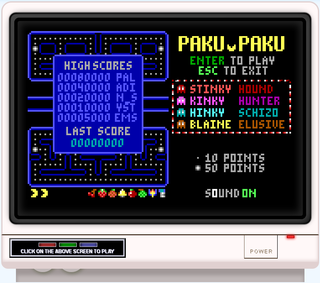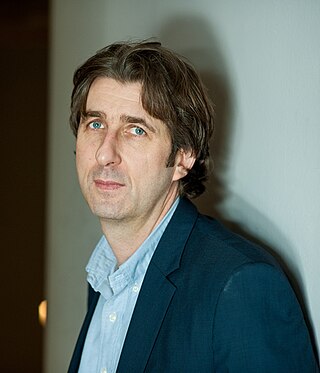Related Research Articles
Interactive fiction, often abbreviated IF, is software simulating environments in which players use text commands to control characters and influence the environment. Works in this form can be understood as literary narratives, either in the form of Interactive narratives or Interactive narrations. These works can also be understood as a form of video game, either in the form of an adventure game or role-playing game. In common usage, the term refers to text adventures, a type of adventure game where the entire interface can be "text-only", however, graphical text adventure games, where the text is accompanied by graphics still fall under the text adventure category if the main way to interact with the game is by typing text. Some users of the term distinguish between interactive fiction, known as "Puzzle-free", that focuses on narrative, and "text adventures" that focus on puzzles.

The history of video games began in the 1950s and 1960s as computer scientists began designing simple games and simulations on minicomputers and mainframes. Spacewar! was developed by Massachusetts Institute of Technology (MIT) student hobbyists in 1962 as one of the first such games on a video display. The first consumer video game hardware was released in the early 1970s. The first home video game console was the Magnavox Odyssey, and the first arcade video games were Computer Space and Pong. After its home console conversions, numerous companies sprang up to capture Pong's success in both the arcade and the home by cloning the game, causing a series of boom and bust cycles due to oversaturation and lack of innovation.
A game engine is a software framework primarily designed for the development of video games and generally includes relevant libraries and support programs such as a level editor. The "engine" terminology is akin to the term "software engine" used more widely in the software industry.

Havok is a middleware software suite developed by the Irish company Havok. Havok provides a physics engine component and related functions to video games.
1996 saw many sequels and prequels in video games, such as Super Mario 64, Duke Nukem 3D, Street Fighter Alpha 2, Super Mario RPG, King's Field III, Virtua Fighter 3, along with new titles such as Blazing Heroes, NiGHTS into Dreams..., Crash Bandicoot, Pokémon Red/Green/Blue, Resident Evil, Dead or Alive, Quake and Tomb Raider.

A personal computer game, also known as a computer game or abbreviated PC game, is a video game played on a personal computer (PC). They are defined by the open platform nature of PC systems.
Mac gaming refers to the use of video games on Macintosh personal computers. In the 1990s, Apple computers did not attract the same level of video game development as Microsoft Windows computers due to the high popularity of Microsoft Windows and, for 3D gaming, Microsoft's DirectX technology. In recent years, the introduction of Mac OS X and support for Intel processors has eased porting of many games, including 3D games through use of OpenGL and more recently Apple's own Metal API. Virtualization technology and Boot Camp also permit the use of Windows and its games on Macintosh computers. Today, a growing number of popular games run natively on macOS, though as of early 2019, a majority still require the use of Microsoft Windows.

Telekinesys Research Limited (TR), doing business as Havok Group, is an Irish software company founded on 9 July 1998 by Hugh Reynolds and Steven Collins, based in Dublin, Ireland, and owned by Microsoft's Ireland Research subsidiary. They have partnerships with Activision, Electronic Arts, Nintendo, Xbox Game Studios, Sony Interactive Entertainment, Bethesda Softworks and Ubisoft.

Michael V. Capps or Mike Capps is an American video game designer who was the president of Epic Games, based in Cary, North Carolina from 2002 to 2012. In 2018, he co-founded a new artificial intelligence company called Howso. He has been described as "a legendary figure in the video game industry."
Murray Goldberg is a noted Canadian educational technologist and a faculty member in the Department of Computer Science at the University of British Columbia in Vancouver, Canada. Goldberg is best known for being the founder of the elearning companies WebCT, Brainify, Silicon Chalk, AssociCom, and Marine Learning Systems. Goldberg was born in Calgary, Alberta, Canada and raised in Edmonton. He moved to British Columbia to attend the University of Victoria in 1980. Murray graduated from UVic in 1985 and then went on to earn an MSc from the University of British Columbia. In 2004 he was awarded an honorary Ph.D. from the Southern Cross University. Murray serves as director for various companies, sits on the board of trustees of Harvey Mudd College in Claremont California, is a mentor at the GSV Labs tech incubator in Redwood City California, and is a frequent consultant and speaker on the future of eLearning. Murray is also the chair of the British Columbia chapter of the Manning Innovation Awards.

Isometric video game graphics are graphics employed in video games and pixel art that use a parallel projection, but which angle the viewpoint to reveal facets of the environment that would otherwise not be visible from a top-down perspective or side view, thereby producing a three-dimensional (3D) effect. Despite the name, isometric computer graphics are not necessarily truly isometric—i.e., the x, y, and z axes are not necessarily oriented 120° to each other. Instead, a variety of angles are used, with dimetric projection and a 2:1 pixel ratio being the most common. The terms "3/4 perspective", "3/4 view", "2.5D", and "pseudo 3D" are also sometimes used, although these terms can bear slightly different meanings in other contexts.
The history of computer animation began as early as the 1940s and 1950s, when people began to experiment with computer graphics – most notably by John Whitney. It was only by the early 1960s when digital computers had become widely established, that new avenues for innovative computer graphics blossomed. Initially, uses were mainly for scientific, engineering and other research purposes, but artistic experimentation began to make its appearance by the mid-1960s – most notably by Dr. Thomas Calvert. By the mid-1970s, many such efforts were beginning to enter into public media. Much computer graphics at this time involved 2-D imagery, though increasingly as computer power improved, efforts to achieve 3-D realism became the emphasis. By the late 1980s, photo-realistic 3-D was beginning to appear in film movies, and by mid-1990s had developed to the point where 3-D animation could be used for entire feature film production.
Games Fleadh, is a 2-day mid-week convention held annually in LIT-Tipperary for computer games enthusiasts and developers to showcase their talent and programming skills. It is usually held in early March and is partially funded by LIT-Tipperary's Centre for Entertainment & Game Technology Research. Additional supporters include Microsoft, EA, and Demonware.
CIIT Philippines - College of Arts and Technology is a private, non-sectarian educational institution in the Philippines that at provides specialized and practical education with a focus on arts, technology, and business.

Martin Kenwright is a British video game designed and the founder of British-based virtual and augmented reality innovation company vTime Limited, digital media, entertainment and technology company Starship, and video game development studios Digital Image Design (DID) and Evolution Studios. He created seminal computer games such as F29 Retaliator and EF2000. He is also responsible for the World Rally Championship franchise and PlayStation 3 launch title, MotorStorm, along with its respective franchise.

Brothers Tim and Chris Stamper are British entrepreneurs who founded the video game companies Ultimate Play the Game and Rare. They first worked together on arcade conversion kits, which were licensed to companies, but later became developers for the ZX Spectrum home computer in the early 1980s. Chris programmed the games, while Tim designed the graphics. They found success as Ultimate with games including Jetpac and Knight Lore. After reverse engineering the Nintendo Entertainment System and deciding to shift their focus to console development, the brothers founded Rare in the mid-1980s. They became Nintendo's first major Western developer, for whom they developed licensed games and ports. Over the next two decades, Rare enjoyed a close relationship with Nintendo and developed multiple major titles for the company, including Donkey Kong Country and GoldenEye 007. Microsoft acquired Rare in 2002, and the brothers left the company in 2007. After spending several years out of the public eye, the brothers are currently planning new ventures.

The Department of Computing (DoC) is the computer science department at Imperial College London. The department has around 50 academic staff and 1000 students, with around 600 studying undergraduate courses, 200 PhD students, and 200 MSc students. The department is predominantly based in the Huxley Building, 180 Queen's Gate, which it shares with the Maths department, however also has space in the William Penney Laboratory and in the Aeronautics and Chemical Engineering Extension. The department ranks 7th in the Times Higher Education 2020 subject world rankings.

The School of Engineering, Trinity College Dublin is the oldest engineering school in Ireland and one of the oldest in the world. It provides undergraduate, taught postgraduate and research degrees in engineering. It is the highest-ranked engineering school in Ireland by QS Rankings and by Times World University Rankings.
Christopher J. Horn is an Irish academic and businessperson, co-founder and CEO of Ireland's first NASDAQ-listed company, IONA Technologies, once one of the world's top ten software-only companies by revenue. He also led fundraising for, and became founding chairperson of, Dublin's Science Gallery, and later its international spinoff projects. Horn, an electronics engineer and holder of a PhD in computer science, has also written extensively on technology and business innovation, and on privacy, including for The Irish Times. A former president of Engineers Ireland, and later made a Fellow of that body, he was awarded an honorary doctorate by Trinity College Dublin, and a Gold Medal of the Royal Dublin Society. He has been chairperson or member of multiple commercial and voluntary boards, including those of Trinity College Dublin and Science Foundation Ireland.
References
- ↑ GV2: the Graphics Vision and Visualisation Group
- ↑ Collins, Steven (1 May 1998). "Game Graphics During the 8-bit Computer Era". ACM SIGGRAPH . 32 (2). Retrieved 25 February 2010.
- 1 2 TCD Innovation Award showcases University and Industry Links Archived 2011-06-06 at the Wayback Machine
- ↑ NovaUCD Entrepreneurs Live! Seminar Series: Dr Steve Collins, co-founder Havok
- ↑ MSc. IET homepage Archived 2008-05-27 at the Wayback Machine
- ↑ Alexander, Leigh. "Havok Buys Kore Virtual Machine". Gamasutra . Retrieved 6 January 2014.
- ↑ "Meet Swrve". Swrve. Retrieved 6 January 2014.